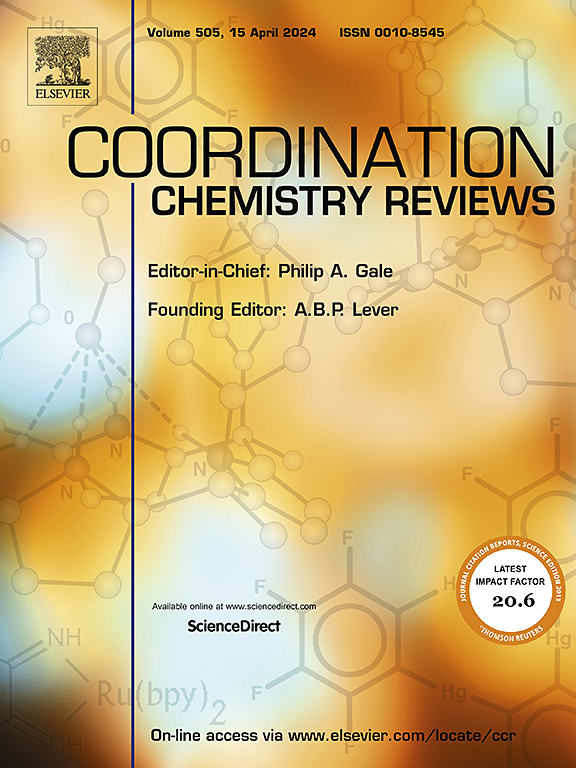Hydroformylation of specific substrates as a perspective route to monomers and valuable bifunctional compounds
IF 23.5
1区 化学
Q1 CHEMISTRY, INORGANIC & NUCLEAR
引用次数: 0
Abstract
This review considers hydroformylation as a pivotal step in the synthesis of bifunctional molecules, the majority of which are critical monomers. The synthesis of bifunctional molecules via hydroformylation is only possible through the transformation of specific substrates (formaldehyde, lower epoxides, 1,3-butadiene, vinyl-, acryl-, allyl-, and oleic derivatives). Consequently, the catalysts utilized and the approaches to the reaction are unique and require a detailed study for each case. The review pays close attention to the distinctive features of these transformations for each group of substrates and undertakes a thorough analysis of the progress and achievements made, while also acknowledging the limitations. Additionally, the role of significant modern developments in the field of hydroformylation, which can also be applied as a powerful and versatile tool for the transformation of more complex substrates (potential monomer precursors), is emphasized. These include the development of new phosphorus-containing ligands for highly active and regioselective homogeneous systems, approaches to tandem transformations (isomerization-hydroformylation, reductive hydroformylation, hydroaminomethylation), and the design of new stable biphasic and heterogeneous systems for simplified catalyst recycling. The most significant advances are highlighted, which may serve for the development of more atom-efficient and environmentally friendly monomer synthesis processes using the hydroformylation step.


特定底物的氢甲酰化是合成单体和有价值的双功能化合物的前景途径
本综述认为氢甲酰化是合成双功能分子的关键步骤,其中大多数是关键单体。通过氢甲酰化合成双功能分子只能通过特定底物(甲醛、低环氧化物、1,3-丁二烯、乙烯基、丙烯酸基、烯丙基和油酸衍生物)的转化来实现。因此,所使用的催化剂和反应的方法是独特的,需要对每种情况进行详细的研究。这篇综述密切关注每组基质的这些转化的独特特征,并对所取得的进展和成就进行了彻底的分析,同时也承认了局限性。此外,强调了氢甲酰化领域的重大现代发展的作用,它也可以作为更复杂底物(潜在单体前体)转化的强大和通用工具。其中包括为高活性和区域选择性的均相体系开发新的含磷配体,实现连续转化(异构化-氢甲酰化、还原性氢甲酰化、氢胺甲基化),以及为简化催化剂回收设计新的稳定的双相和非均相体系。强调了最重要的进展,这可能有助于利用氢甲酰化步骤开发更具原子效率和环境友好的单体合成工艺。
本文章由计算机程序翻译,如有差异,请以英文原文为准。
求助全文
约1分钟内获得全文
求助全文
来源期刊

Coordination Chemistry Reviews
化学-无机化学与核化学
CiteScore
34.30
自引率
5.30%
发文量
457
审稿时长
54 days
期刊介绍:
Coordination Chemistry Reviews offers rapid publication of review articles on current and significant topics in coordination chemistry, encompassing organometallic, supramolecular, theoretical, and bioinorganic chemistry. It also covers catalysis, materials chemistry, and metal-organic frameworks from a coordination chemistry perspective. Reviews summarize recent developments or discuss specific techniques, welcoming contributions from both established and emerging researchers.
The journal releases special issues on timely subjects, including those featuring contributions from specific regions or conferences. Occasional full-length book articles are also featured. Additionally, special volumes cover annual reviews of main group chemistry, transition metal group chemistry, and organometallic chemistry. These comprehensive reviews are vital resources for those engaged in coordination chemistry, further establishing Coordination Chemistry Reviews as a hub for insightful surveys in inorganic and physical inorganic chemistry.
 求助内容:
求助内容: 应助结果提醒方式:
应助结果提醒方式:


